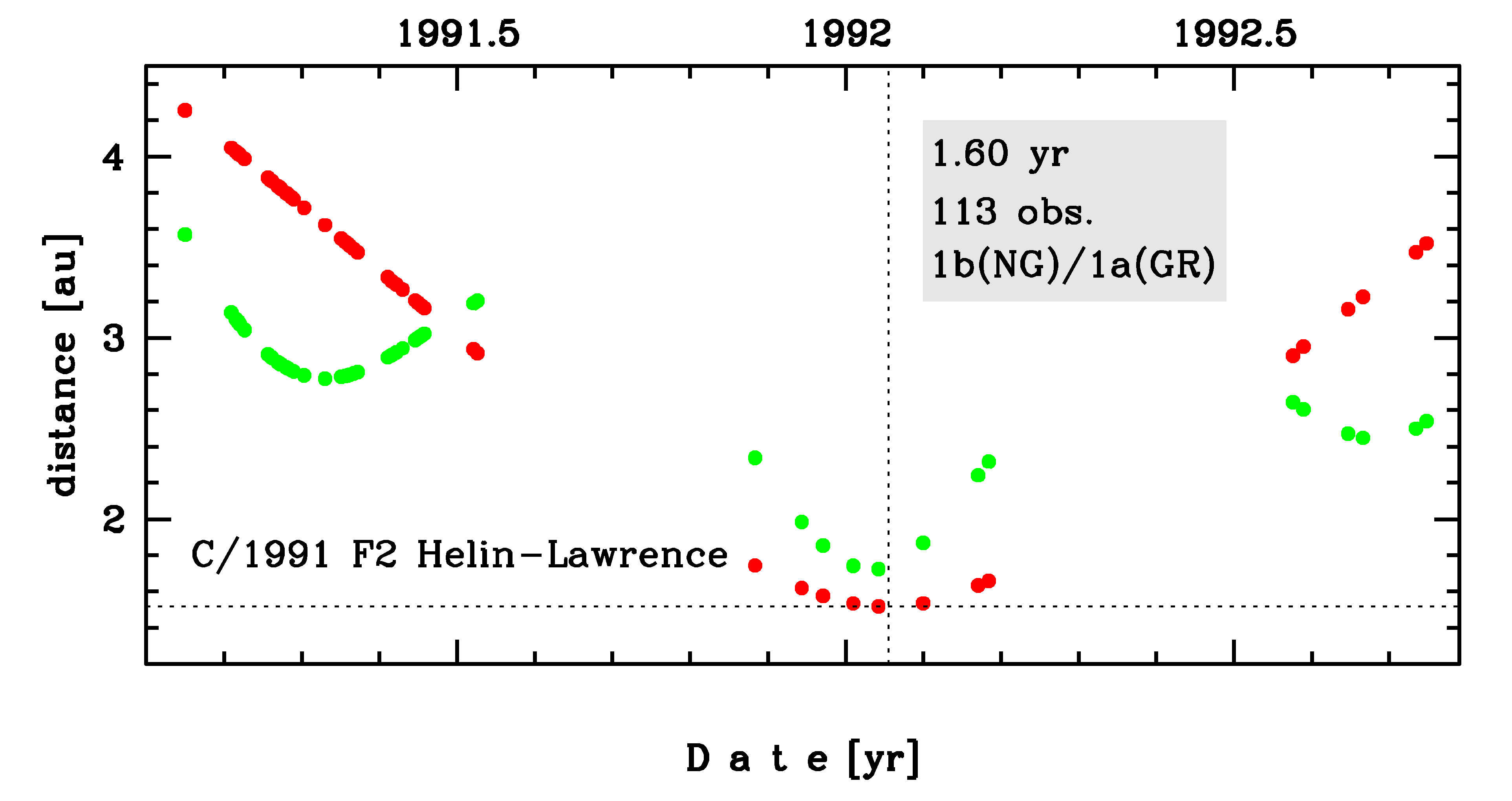C/1991 F2 Helin-Lawrence
more info
Comet C/1991 F2 was discovered on 17 March 1991 by Eleanor F. Helin and Kenneth J. Lawrence (Mount Palomar, California, USA), that is about 10 months before its perihelion passage. This comet was last observed at the end of September 1992.
Comet had its closest approach to the Earth on 12 January 1992 (1.721 au), 8 days before perihelion passage.
Solutions given here are based on data spanning over 1.60 yr in a range of heliocentric distances: 4.25 au – 1.52 au (perihelion) – 3.52 au.
This Oort spike comet suffers tiny planetary perturbations during its passage through the planetary system; however, these perturbations lead to escape the comet on hyperbolic orbit from the planetary zone.
See also Królikowska 2014 and Królikowska 2020.
Comet had its closest approach to the Earth on 12 January 1992 (1.721 au), 8 days before perihelion passage.
Solutions given here are based on data spanning over 1.60 yr in a range of heliocentric distances: 4.25 au – 1.52 au (perihelion) – 3.52 au.
This Oort spike comet suffers tiny planetary perturbations during its passage through the planetary system; however, these perturbations lead to escape the comet on hyperbolic orbit from the planetary zone.
See also Królikowska 2014 and Królikowska 2020.
| solution description | ||
|---|---|---|
| number of observations | 113 | |
| data interval | 1991 02 23 – 1992 09 30 | |
| data type | perihelion within the observation arc (FULL) | |
| data arc selection | entire data set (STD) | |
| range of heliocentric distances | 4.25 au – 1.52 au (perihelion) – 3.52 au | |
| type of model of motion | NS - non-gravitational orbits for standard g(r) | |
| data weighting | YES | |
| number of residuals | 213 | |
| RMS [arcseconds] | 0.78 | |
| orbit quality class | 1b | |
| previous orbit statistics, both Galactic and stellar perturbations were taken into account | ||
|---|---|---|
| no. of returning VCs in the swarm | 728 | |
| no. of escaping VCs in the swarm | 4273 | * |
| no. of hyperbolas among escaping VCs in the swarm | 24 | |
| previous reciprocal semi-major axis [10-6 au-1] | 5.63 – 11.24 – 17.00 | |
| previous perihelion distance [au] | 1000 – 1200 – 1400 | |
| previous aphelion distance [103 au] | 120 – 180 – 350 | |
| time interval to previous perihelion [Myr] | 3.07 ± 12 | |
| percentage of VCs with qprev > 20 | 100 | |
| previous_g orbit statistics, here only the Galactic tide has been included | ||
|---|---|---|
| no. of returning VCs in the swarm | 1733 | |
| no. of escaping VCs in the swarm | 3268 | * |
| no. of hyperbolas among escaping VCs in the swarm | 0 | |
| previous reciprocal semi-major axis [10-6 au-1] | 9.76 – 14.80 – 19.91 | |
| previous perihelion distance [au] | 160 – 450 – 790 | R |
| previous aphelion distance [103 au] | 100 – 140 – 200 | |
| time interval to previous perihelion [Myr] | 9.5 – 12 – 14 | R |
| percentage of VCs with qprev > 20 | 100 | |
